Digital Transformation Business Model Analysis Report
VerifiedAdded on 2022/08/10
|6
|1398
|176
Report
AI Summary
This report delves into the complexities of digital transformation within a business context. It begins by identifying key challenges, such as evolving customer experiences, employee resistance, and difficulties in leveraging customer data. The report then examines the current distributor business model, highlighting declining revenues and increasing investment needs. A proposed solution is presented: an e-commerce business model, which is expected to enhance customer satisfaction, expand market reach, and optimize data utilization. The report concludes by emphasizing the advantages of the e-commerce model, including increased customer convenience, cost savings, and the ability to provide personalized services. It underscores the project's potential to overcome the limitations of the traditional business model and drive company success.
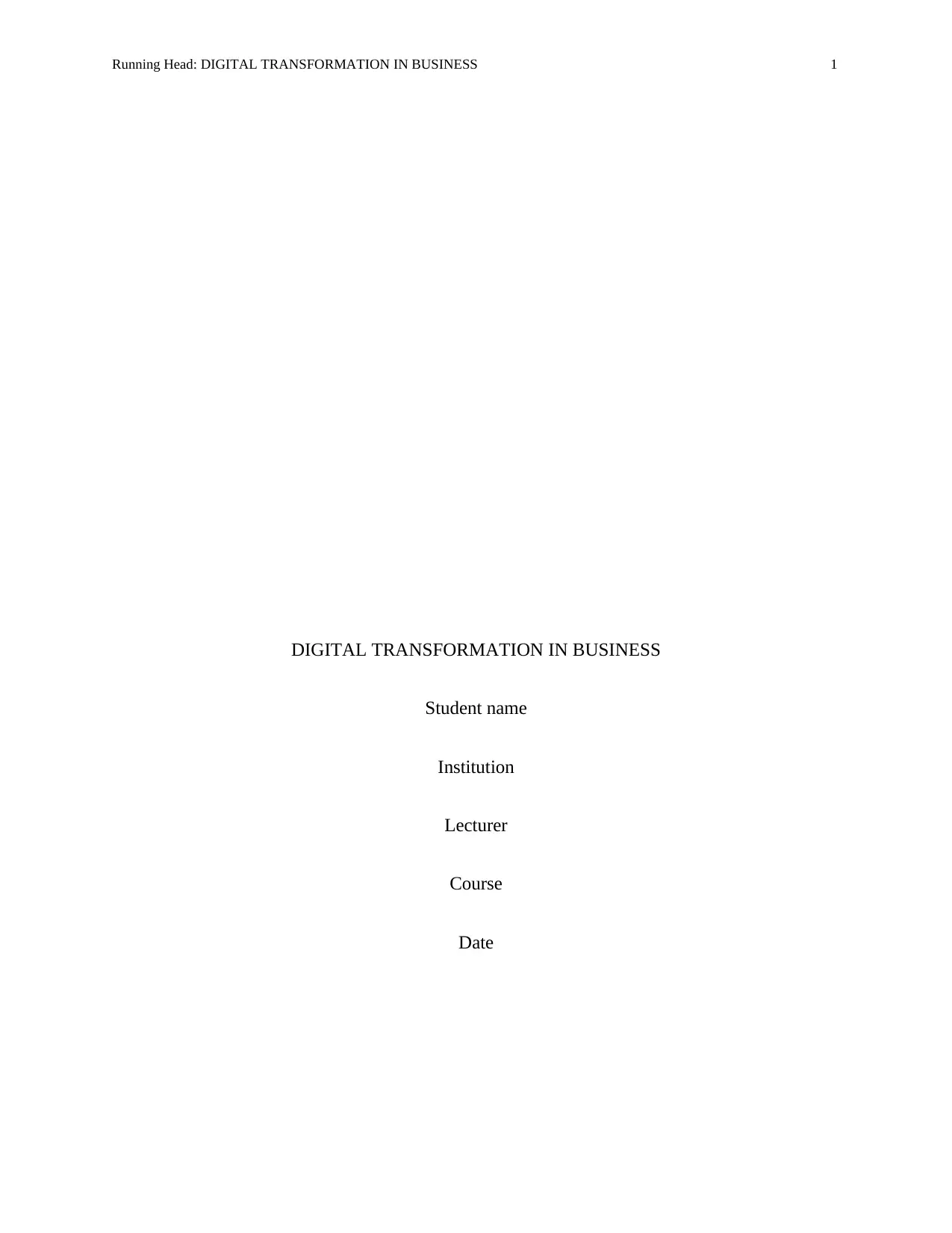
Running Head: DIGITAL TRANSFORMATION IN BUSINESS 1
DIGITAL TRANSFORMATION IN BUSINESS
Student name
Institution
Lecturer
Course
Date
DIGITAL TRANSFORMATION IN BUSINESS
Student name
Institution
Lecturer
Course
Date
Paraphrase This Document
Need a fresh take? Get an instant paraphrase of this document with our AI Paraphraser
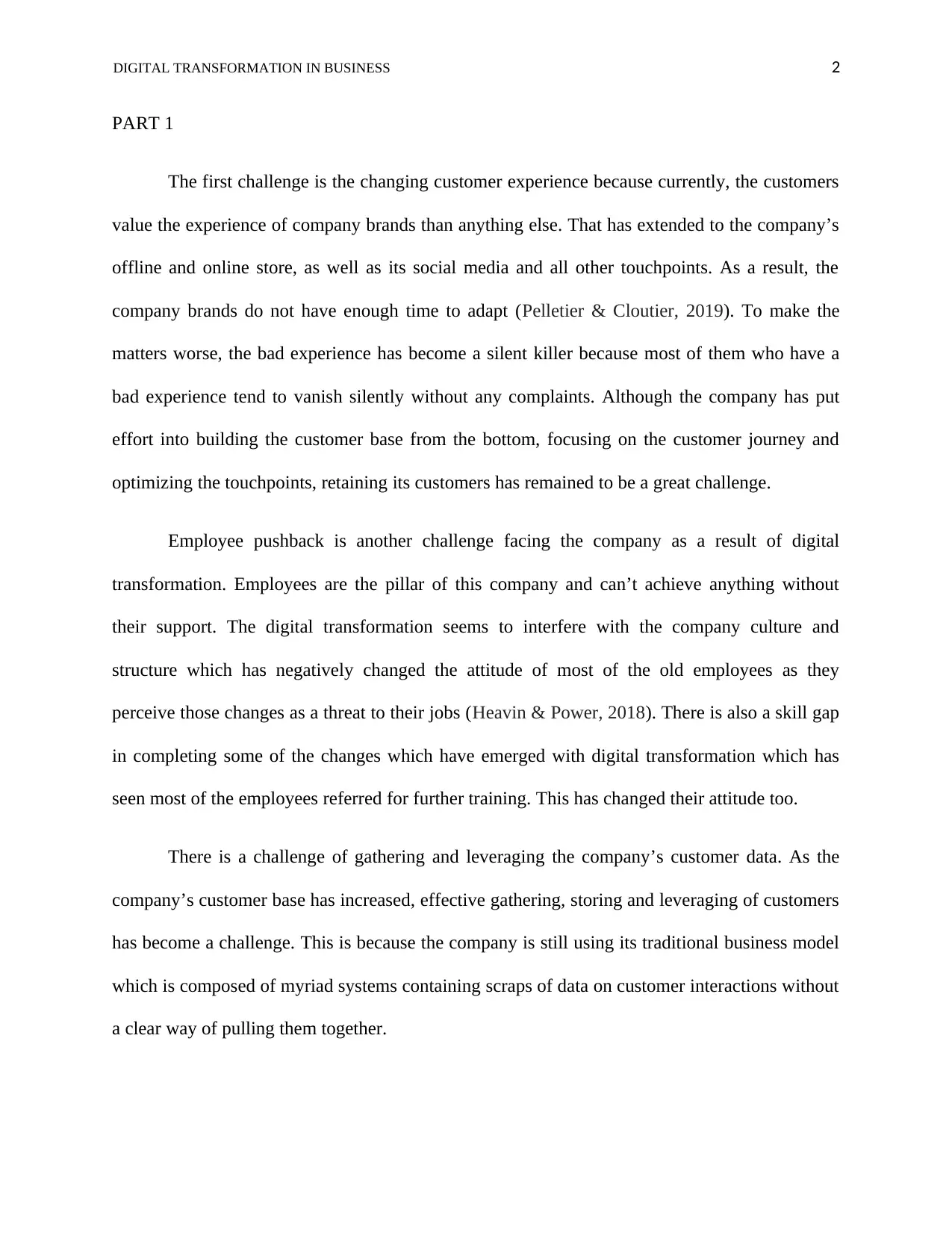
DIGITAL TRANSFORMATION IN BUSINESS 2
PART 1
The first challenge is the changing customer experience because currently, the customers
value the experience of company brands than anything else. That has extended to the company’s
offline and online store, as well as its social media and all other touchpoints. As a result, the
company brands do not have enough time to adapt (Pelletier & Cloutier, 2019). To make the
matters worse, the bad experience has become a silent killer because most of them who have a
bad experience tend to vanish silently without any complaints. Although the company has put
effort into building the customer base from the bottom, focusing on the customer journey and
optimizing the touchpoints, retaining its customers has remained to be a great challenge.
Employee pushback is another challenge facing the company as a result of digital
transformation. Employees are the pillar of this company and can’t achieve anything without
their support. The digital transformation seems to interfere with the company culture and
structure which has negatively changed the attitude of most of the old employees as they
perceive those changes as a threat to their jobs (Heavin & Power, 2018). There is also a skill gap
in completing some of the changes which have emerged with digital transformation which has
seen most of the employees referred for further training. This has changed their attitude too.
There is a challenge of gathering and leveraging the company’s customer data. As the
company’s customer base has increased, effective gathering, storing and leveraging of customers
has become a challenge. This is because the company is still using its traditional business model
which is composed of myriad systems containing scraps of data on customer interactions without
a clear way of pulling them together.
PART 1
The first challenge is the changing customer experience because currently, the customers
value the experience of company brands than anything else. That has extended to the company’s
offline and online store, as well as its social media and all other touchpoints. As a result, the
company brands do not have enough time to adapt (Pelletier & Cloutier, 2019). To make the
matters worse, the bad experience has become a silent killer because most of them who have a
bad experience tend to vanish silently without any complaints. Although the company has put
effort into building the customer base from the bottom, focusing on the customer journey and
optimizing the touchpoints, retaining its customers has remained to be a great challenge.
Employee pushback is another challenge facing the company as a result of digital
transformation. Employees are the pillar of this company and can’t achieve anything without
their support. The digital transformation seems to interfere with the company culture and
structure which has negatively changed the attitude of most of the old employees as they
perceive those changes as a threat to their jobs (Heavin & Power, 2018). There is also a skill gap
in completing some of the changes which have emerged with digital transformation which has
seen most of the employees referred for further training. This has changed their attitude too.
There is a challenge of gathering and leveraging the company’s customer data. As the
company’s customer base has increased, effective gathering, storing and leveraging of customers
has become a challenge. This is because the company is still using its traditional business model
which is composed of myriad systems containing scraps of data on customer interactions without
a clear way of pulling them together.
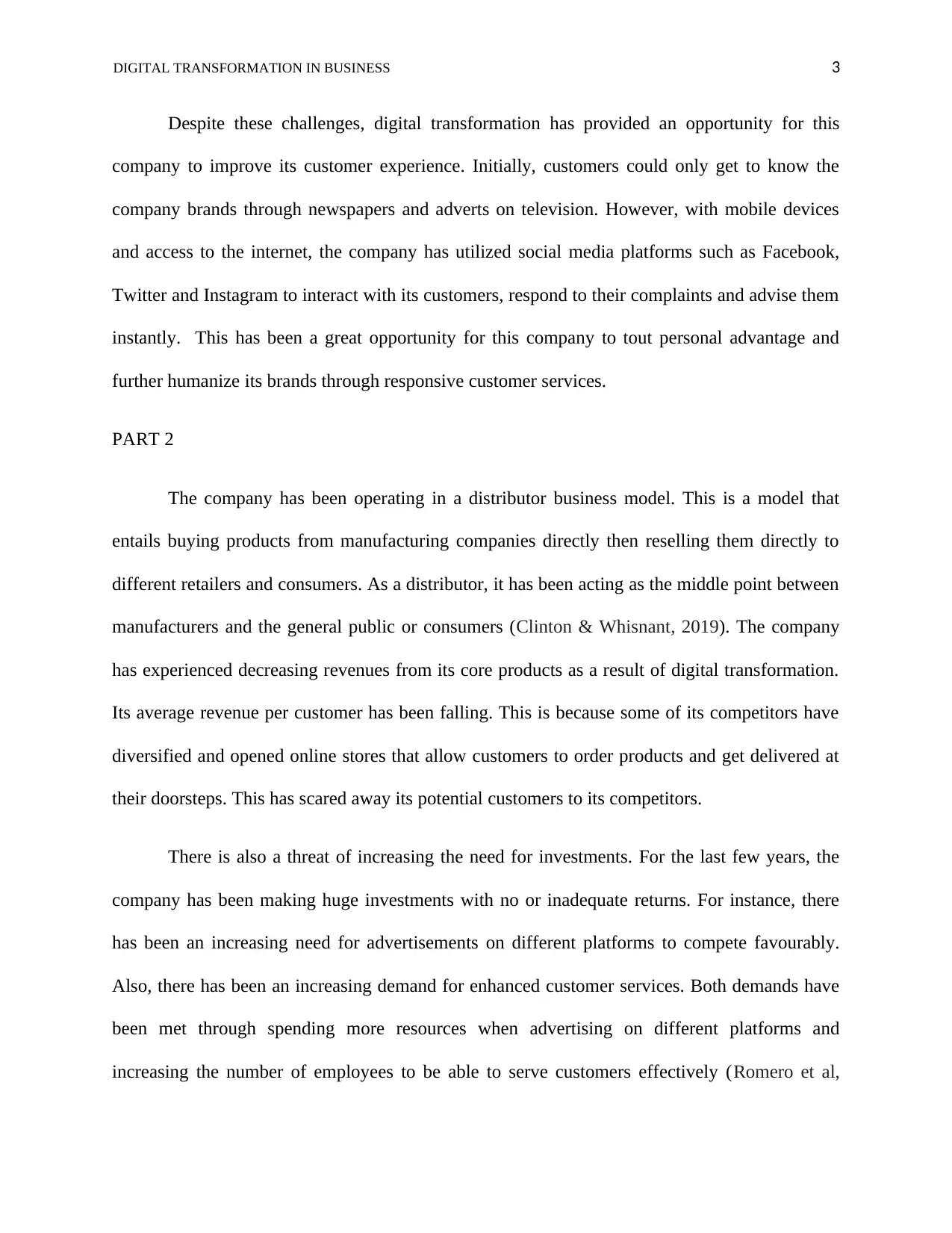
DIGITAL TRANSFORMATION IN BUSINESS 3
Despite these challenges, digital transformation has provided an opportunity for this
company to improve its customer experience. Initially, customers could only get to know the
company brands through newspapers and adverts on television. However, with mobile devices
and access to the internet, the company has utilized social media platforms such as Facebook,
Twitter and Instagram to interact with its customers, respond to their complaints and advise them
instantly. This has been a great opportunity for this company to tout personal advantage and
further humanize its brands through responsive customer services.
PART 2
The company has been operating in a distributor business model. This is a model that
entails buying products from manufacturing companies directly then reselling them directly to
different retailers and consumers. As a distributor, it has been acting as the middle point between
manufacturers and the general public or consumers (Clinton & Whisnant, 2019). The company
has experienced decreasing revenues from its core products as a result of digital transformation.
Its average revenue per customer has been falling. This is because some of its competitors have
diversified and opened online stores that allow customers to order products and get delivered at
their doorsteps. This has scared away its potential customers to its competitors.
There is also a threat of increasing the need for investments. For the last few years, the
company has been making huge investments with no or inadequate returns. For instance, there
has been an increasing need for advertisements on different platforms to compete favourably.
Also, there has been an increasing demand for enhanced customer services. Both demands have
been met through spending more resources when advertising on different platforms and
increasing the number of employees to be able to serve customers effectively (Romero et al,
Despite these challenges, digital transformation has provided an opportunity for this
company to improve its customer experience. Initially, customers could only get to know the
company brands through newspapers and adverts on television. However, with mobile devices
and access to the internet, the company has utilized social media platforms such as Facebook,
Twitter and Instagram to interact with its customers, respond to their complaints and advise them
instantly. This has been a great opportunity for this company to tout personal advantage and
further humanize its brands through responsive customer services.
PART 2
The company has been operating in a distributor business model. This is a model that
entails buying products from manufacturing companies directly then reselling them directly to
different retailers and consumers. As a distributor, it has been acting as the middle point between
manufacturers and the general public or consumers (Clinton & Whisnant, 2019). The company
has experienced decreasing revenues from its core products as a result of digital transformation.
Its average revenue per customer has been falling. This is because some of its competitors have
diversified and opened online stores that allow customers to order products and get delivered at
their doorsteps. This has scared away its potential customers to its competitors.
There is also a threat of increasing the need for investments. For the last few years, the
company has been making huge investments with no or inadequate returns. For instance, there
has been an increasing need for advertisements on different platforms to compete favourably.
Also, there has been an increasing demand for enhanced customer services. Both demands have
been met through spending more resources when advertising on different platforms and
increasing the number of employees to be able to serve customers effectively (Romero et al,
⊘ This is a preview!⊘
Do you want full access?
Subscribe today to unlock all pages.

Trusted by 1+ million students worldwide
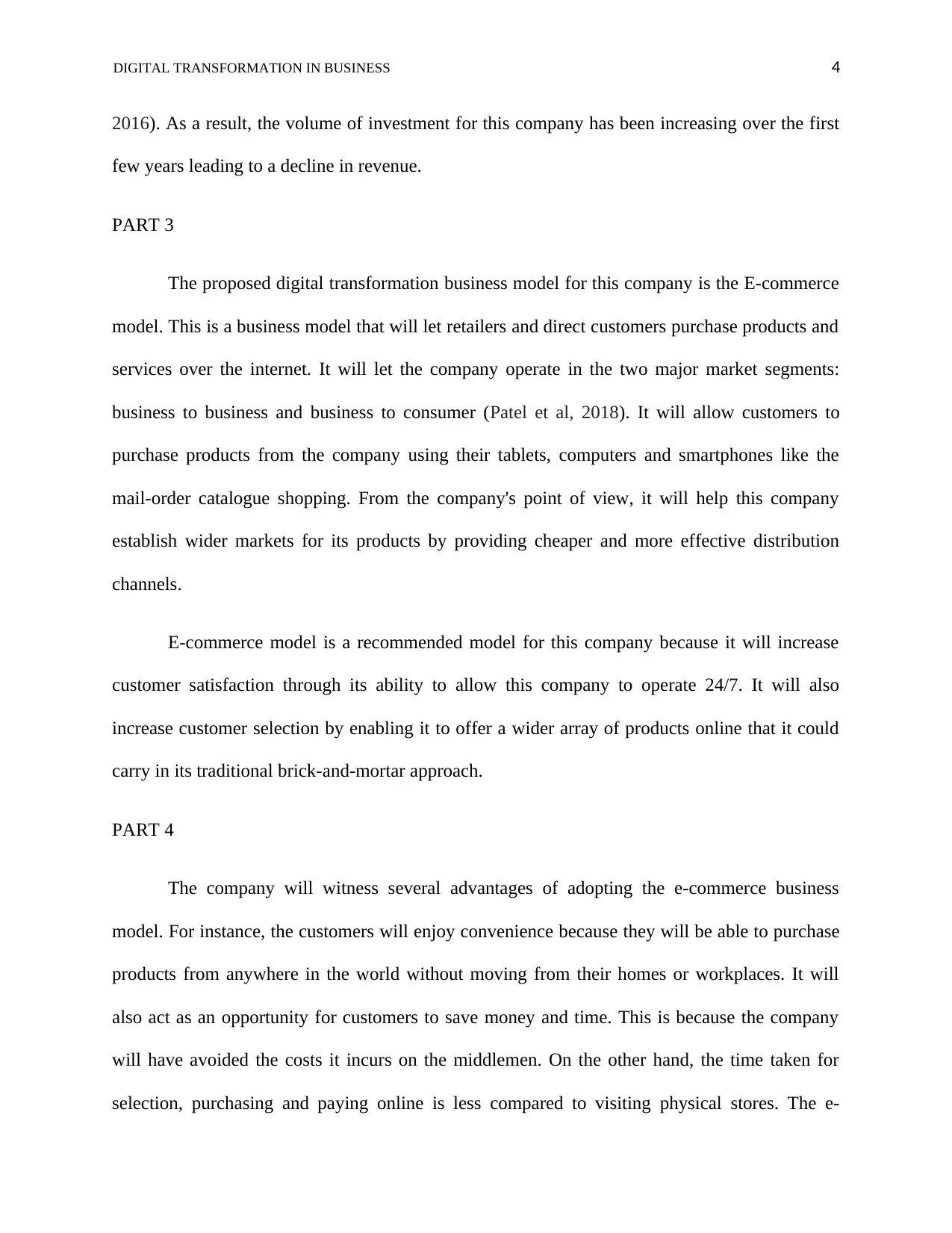
DIGITAL TRANSFORMATION IN BUSINESS 4
2016). As a result, the volume of investment for this company has been increasing over the first
few years leading to a decline in revenue.
PART 3
The proposed digital transformation business model for this company is the E-commerce
model. This is a business model that will let retailers and direct customers purchase products and
services over the internet. It will let the company operate in the two major market segments:
business to business and business to consumer (Patel et al, 2018). It will allow customers to
purchase products from the company using their tablets, computers and smartphones like the
mail-order catalogue shopping. From the company's point of view, it will help this company
establish wider markets for its products by providing cheaper and more effective distribution
channels.
E-commerce model is a recommended model for this company because it will increase
customer satisfaction through its ability to allow this company to operate 24/7. It will also
increase customer selection by enabling it to offer a wider array of products online that it could
carry in its traditional brick-and-mortar approach.
PART 4
The company will witness several advantages of adopting the e-commerce business
model. For instance, the customers will enjoy convenience because they will be able to purchase
products from anywhere in the world without moving from their homes or workplaces. It will
also act as an opportunity for customers to save money and time. This is because the company
will have avoided the costs it incurs on the middlemen. On the other hand, the time taken for
selection, purchasing and paying online is less compared to visiting physical stores. The e-
2016). As a result, the volume of investment for this company has been increasing over the first
few years leading to a decline in revenue.
PART 3
The proposed digital transformation business model for this company is the E-commerce
model. This is a business model that will let retailers and direct customers purchase products and
services over the internet. It will let the company operate in the two major market segments:
business to business and business to consumer (Patel et al, 2018). It will allow customers to
purchase products from the company using their tablets, computers and smartphones like the
mail-order catalogue shopping. From the company's point of view, it will help this company
establish wider markets for its products by providing cheaper and more effective distribution
channels.
E-commerce model is a recommended model for this company because it will increase
customer satisfaction through its ability to allow this company to operate 24/7. It will also
increase customer selection by enabling it to offer a wider array of products online that it could
carry in its traditional brick-and-mortar approach.
PART 4
The company will witness several advantages of adopting the e-commerce business
model. For instance, the customers will enjoy convenience because they will be able to purchase
products from anywhere in the world without moving from their homes or workplaces. It will
also act as an opportunity for customers to save money and time. This is because the company
will have avoided the costs it incurs on the middlemen. On the other hand, the time taken for
selection, purchasing and paying online is less compared to visiting physical stores. The e-
Paraphrase This Document
Need a fresh take? Get an instant paraphrase of this document with our AI Paraphraser
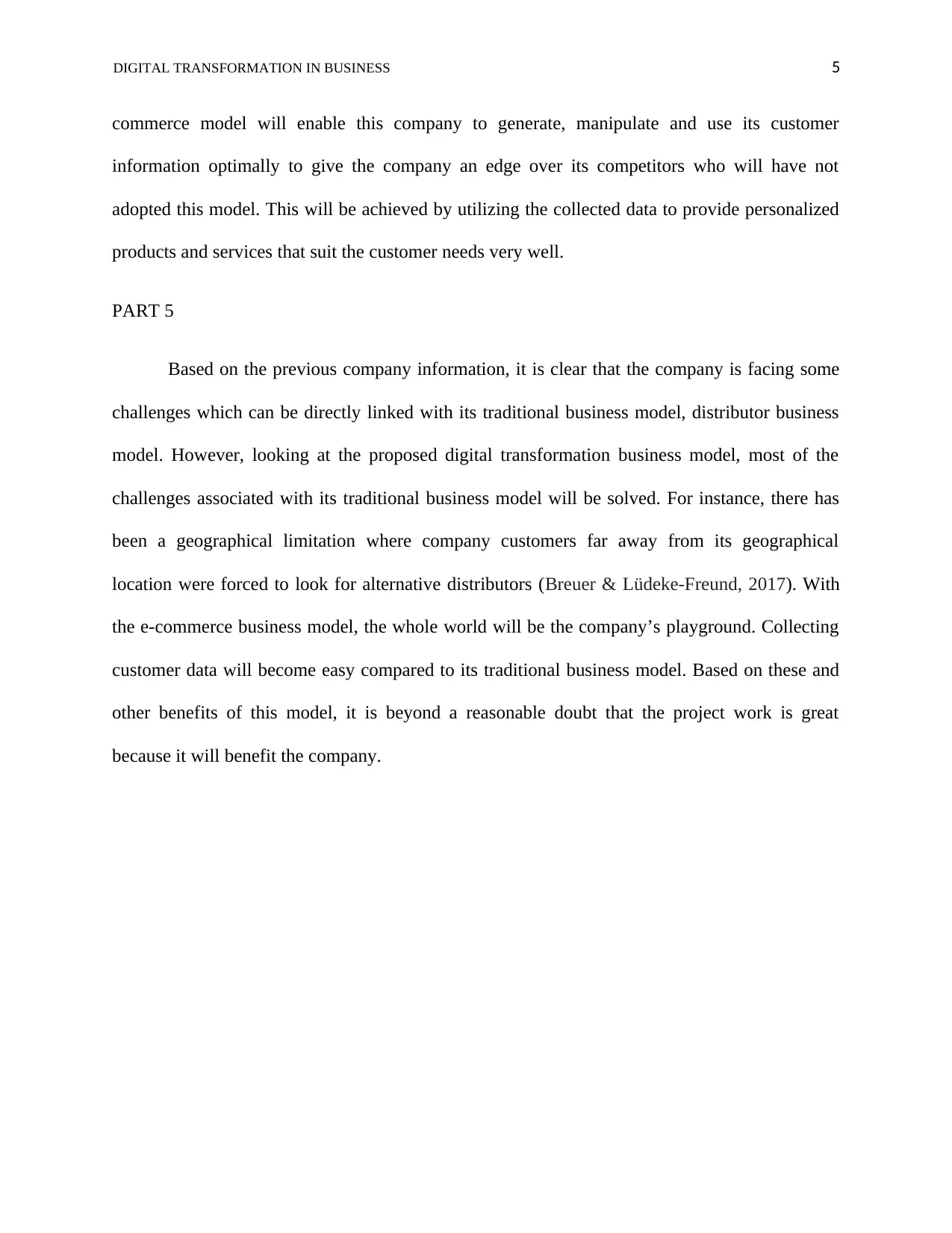
DIGITAL TRANSFORMATION IN BUSINESS 5
commerce model will enable this company to generate, manipulate and use its customer
information optimally to give the company an edge over its competitors who will have not
adopted this model. This will be achieved by utilizing the collected data to provide personalized
products and services that suit the customer needs very well.
PART 5
Based on the previous company information, it is clear that the company is facing some
challenges which can be directly linked with its traditional business model, distributor business
model. However, looking at the proposed digital transformation business model, most of the
challenges associated with its traditional business model will be solved. For instance, there has
been a geographical limitation where company customers far away from its geographical
location were forced to look for alternative distributors (Breuer & Lüdeke-Freund, 2017). With
the e-commerce business model, the whole world will be the company’s playground. Collecting
customer data will become easy compared to its traditional business model. Based on these and
other benefits of this model, it is beyond a reasonable doubt that the project work is great
because it will benefit the company.
commerce model will enable this company to generate, manipulate and use its customer
information optimally to give the company an edge over its competitors who will have not
adopted this model. This will be achieved by utilizing the collected data to provide personalized
products and services that suit the customer needs very well.
PART 5
Based on the previous company information, it is clear that the company is facing some
challenges which can be directly linked with its traditional business model, distributor business
model. However, looking at the proposed digital transformation business model, most of the
challenges associated with its traditional business model will be solved. For instance, there has
been a geographical limitation where company customers far away from its geographical
location were forced to look for alternative distributors (Breuer & Lüdeke-Freund, 2017). With
the e-commerce business model, the whole world will be the company’s playground. Collecting
customer data will become easy compared to its traditional business model. Based on these and
other benefits of this model, it is beyond a reasonable doubt that the project work is great
because it will benefit the company.
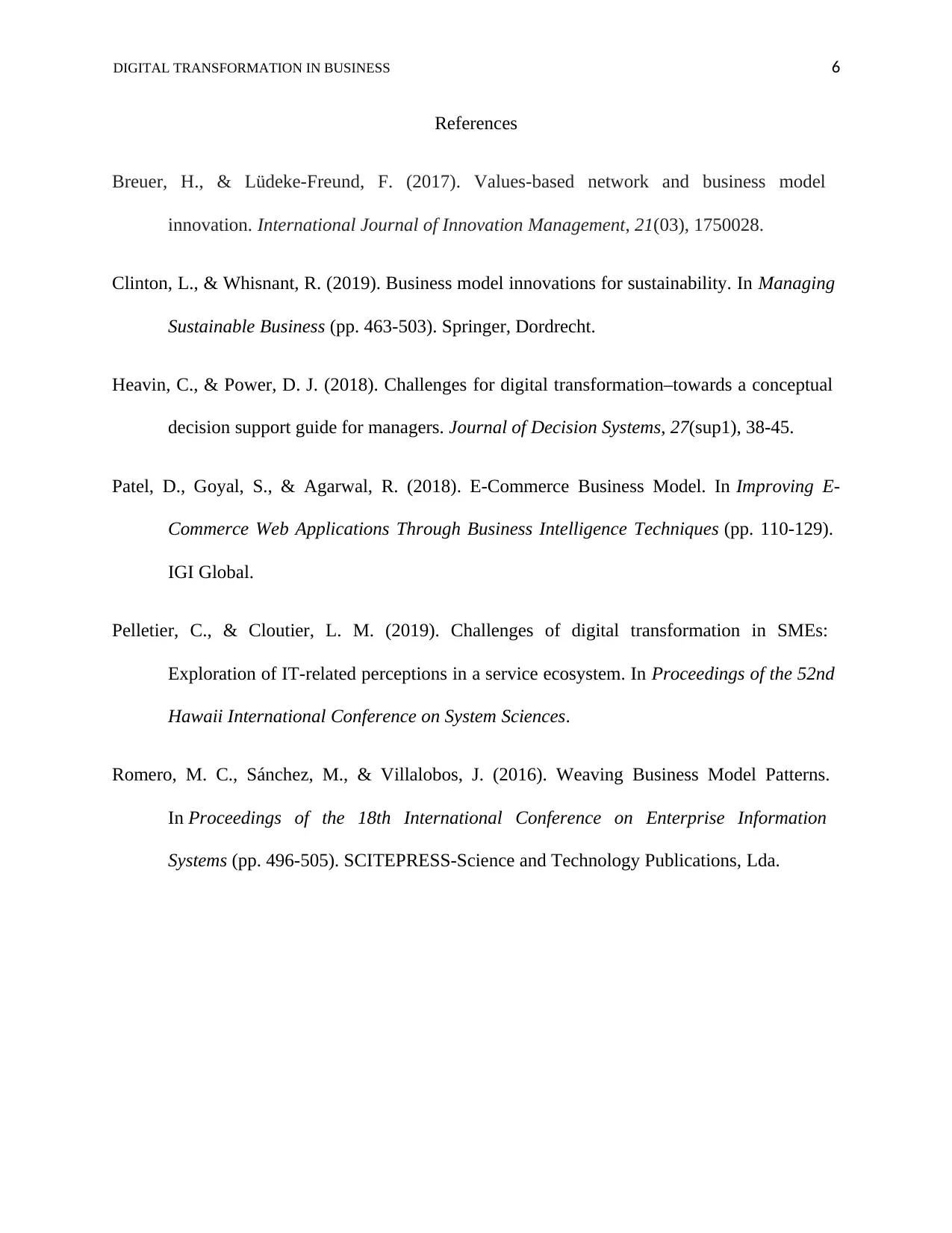
DIGITAL TRANSFORMATION IN BUSINESS 6
References
Breuer, H., & Lüdeke-Freund, F. (2017). Values-based network and business model
innovation. International Journal of Innovation Management, 21(03), 1750028.
Clinton, L., & Whisnant, R. (2019). Business model innovations for sustainability. In Managing
Sustainable Business (pp. 463-503). Springer, Dordrecht.
Heavin, C., & Power, D. J. (2018). Challenges for digital transformation–towards a conceptual
decision support guide for managers. Journal of Decision Systems, 27(sup1), 38-45.
Patel, D., Goyal, S., & Agarwal, R. (2018). E-Commerce Business Model. In Improving E-
Commerce Web Applications Through Business Intelligence Techniques (pp. 110-129).
IGI Global.
Pelletier, C., & Cloutier, L. M. (2019). Challenges of digital transformation in SMEs:
Exploration of IT-related perceptions in a service ecosystem. In Proceedings of the 52nd
Hawaii International Conference on System Sciences.
Romero, M. C., Sánchez, M., & Villalobos, J. (2016). Weaving Business Model Patterns.
In Proceedings of the 18th International Conference on Enterprise Information
Systems (pp. 496-505). SCITEPRESS-Science and Technology Publications, Lda.
References
Breuer, H., & Lüdeke-Freund, F. (2017). Values-based network and business model
innovation. International Journal of Innovation Management, 21(03), 1750028.
Clinton, L., & Whisnant, R. (2019). Business model innovations for sustainability. In Managing
Sustainable Business (pp. 463-503). Springer, Dordrecht.
Heavin, C., & Power, D. J. (2018). Challenges for digital transformation–towards a conceptual
decision support guide for managers. Journal of Decision Systems, 27(sup1), 38-45.
Patel, D., Goyal, S., & Agarwal, R. (2018). E-Commerce Business Model. In Improving E-
Commerce Web Applications Through Business Intelligence Techniques (pp. 110-129).
IGI Global.
Pelletier, C., & Cloutier, L. M. (2019). Challenges of digital transformation in SMEs:
Exploration of IT-related perceptions in a service ecosystem. In Proceedings of the 52nd
Hawaii International Conference on System Sciences.
Romero, M. C., Sánchez, M., & Villalobos, J. (2016). Weaving Business Model Patterns.
In Proceedings of the 18th International Conference on Enterprise Information
Systems (pp. 496-505). SCITEPRESS-Science and Technology Publications, Lda.
⊘ This is a preview!⊘
Do you want full access?
Subscribe today to unlock all pages.

Trusted by 1+ million students worldwide
1 out of 6
Related Documents
Your All-in-One AI-Powered Toolkit for Academic Success.
+13062052269
info@desklib.com
Available 24*7 on WhatsApp / Email
![[object Object]](/_next/static/media/star-bottom.7253800d.svg)
Unlock your academic potential
Copyright © 2020–2025 A2Z Services. All Rights Reserved. Developed and managed by ZUCOL.





